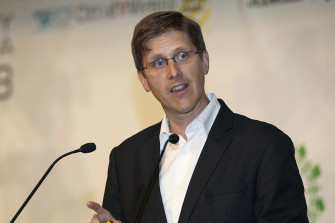
Philippe Crist – “21st Century Cities Won’t Work Without Cycling”
Keynote speaker Philippe Crist kicks off our interview series with the key participants at Velo-city 2013. We have spoken with Philippe about cycling in the 21st century - and, above all, in developing countries.
Paris, 16th arrondissement, right next to the Eiffel tower. Here, at the OECD headquarters, the economists, statisticians and policy analysts of the International Transport Forum (ITF) are working to understand the challenges to mobility in the 21st century.
One of the world's most prestigious think tanks for mobility, ITF is also an intergovernmental organization. Its members are 54 transport ministers from OECD member countries and beyond. Once a year, the ITF brings them all together at its Annual Summit in Leipzig, in order to engage a global conversation about the changing face of transport in a globalized world.
As an economist and administrator, Philippe Crist is responsible for several of ITF's research initiatives and serves on the advisory boards for several transport, climate change and urban policy research programmes. A passionate and competitive cyclist, he delivered the keynote at ECF's Velo-City 2013 conference. We have asked him what he thinks the future of mobility and cycling will look like.
Question: Philippe Crist, as a researcher at the International Transport Forum, what is your prediction about mobility in the 21st century?
Philippe Crist: The growth in mobility in the developing world is going to be staggering. We estimate that the cumulative growth in trips from now to 2050 will be 54 trillion with 94 percent of that growth taking place in urban areas and 97 percent of those trips occurring in developing countries. The developing world is urbanizing very quickly, and with that people’s mobility needs are changing.
What’s fundamental to this is increasing in wealth in developing countries. With this increase in wealth, we see that there are two historical tendencies that still hold true: once people want to get wealthier, they move to a city. And once they are richer, they want to move further and faster.
What problems does this create?
One of the main issues is that wealth in developing countries isn’t growing equitably, and that’s also true for mobility. Poor people often do not benefit from improvements in mobility. Of course, once people move out of poverty and purchase motorbikes and cars, existing infrastructure often cannot keep up and handle the growing traffic. Congestion erodes many of the benefits of living in cities.
What can be done to relieve the pressure on transport networks in the developing world? Can cycling play a role?
Cycling is indeed a solution that’s often overlooked. Cycling can be an access enhancer; it gets you where you want quickly and more affordably than any other form of transport, and most of all it's accessible to anyone, rich or poor.
I would call cycling a 'city safety valve', because more people cycling can help a great deal in alleviating the overload on transport networks while still moving people around efficiently. With traffic expected to grow a lot more, it’s safe to say that 21st century cities won’t work without cycling and walking.
How many people still cycle today in the emerging economies?
Cycling shares in developing countries are often much higher than in North America or the EU. It’s not
uncommon to have a 25 to 30 percent cycling share in big cities in China or India, but the share is falling rapidly. The challenge is to lock in cycling at these levels and keep them from falling further.
That means we need very different strategies for cycling in developing countries and industrial countries. How do you explain the difference?
The main challenge is to make cycling socially acceptable. To explain this, I use the ‘invisibility’ metaphor. There is good invisibility and bad invisibility. Good invisibility is what we have in the Netherlands or Denmark: cyclists are so common and well-accepted that you don't even notice them anymore.
Bad invisibility is what we currently have in many places in de developing world. There are as many cyclists as in Europe's most cycling-friendly countries in fact, but they are all but invisible to traffic planners. In many developing countries cycling and walking do not even count as ‘traffic’. But they should, of course!
Isn’t cycling safety an issue as well?
Yes, cycling is very unsafe in many developing countries, or is regarded as very unsafe. That's one reason why many people buy a car as soon as they can afford it. But it is unsafe because nothing is made to make it safe.
If we want to increase cycling in these cities– and there are many compelling reasons why we should –a choice must be made: do we focus on protecting cyclists from cars, trucks and motorbikes in what remains an inherently unsafe traffic system? Or do we choose to make the system safe by creating the right infrastructure, allocating space equitably for all road users, and introduce speed limits?
Given the importance of cycling, I think we should choose the second option. But these decisions are taken by planners and politicians, so political commitment is very important.
But aren’t lacking political will and bad planning a problem in many developing countries?
Often it’s true that cities lack decent planning and commitment from politicians – but that's the case in many places in developed countries as well.
There are some very encouraging examples from emerging countries indeed. Colombia’s capital Bogotà has built a comprehensive and well-used bicycle network and has been a strong supporter of cycling. Guangzhou and other cities in China have introduced license plate lotteries for car owners and implemented large-scale bike sharing schemes. And Kaohsiung in Taiwan has embraced cycling with a very well-working bike sharing scheme and decent bike paths all around the city. These are only a few, but they exist.
What’s more, many of these cities are learning from their peers in other emerging countries – this is a very encouraging trend!
So do you think the city of the future will be a cycling city?
In fact, I think it’s hard to imagine a city with only cyclists. We have to think about integrating Public Transport and Cycling. Linking the two is crucial for success, because cycling can boost Public Transport.
Cycling allows you to increase the range of Public Transport. In Paris, for example, many people take the suburban train to the city center and then continue on a Velib’, one of the city’s shared bikes. In Tokyo, it's the other way round: people cycle from their home to the nearest train station. Once in the city center, which is very dense, they will use public transport to get around.
If cycling is to grow in cities, it must be perceived and experienced as a superior option for the range of trips that one can do best on a bike. In order to achieve this, cities need to integrate well-planned and designed cycling networks with other transport networks and services.
Is there some universal advice you could give to people who want to cycle, be it in Paris, Delhi, Tokyo, or Beijing?
There's one main reason to cycle that applies everywhere: cycling is just plain fun!
Interview: Karsten Marhold
About the Author
 Karsten Marhold works as Communications Assistant at the European Cyclists’ Federation. He has a masters degree in European history and cultures and is a researcher in European Integration in Brussels. His interests focus on cycling as a sustainable form of mobility and the corresponding EU policies.
Karsten Marhold works as Communications Assistant at the European Cyclists’ Federation. He has a masters degree in European history and cultures and is a researcher in European Integration in Brussels. His interests focus on cycling as a sustainable form of mobility and the corresponding EU policies.
- Log in to post comments
Contact the author
Recent news!
Upcoming events
Contact Us
Avenue des Arts, 7-8
Postal address: Rue de la Charité, 22
1210 Brussels, Belgium











